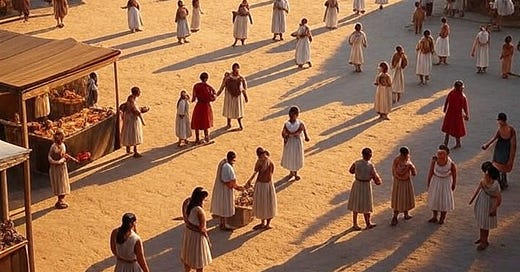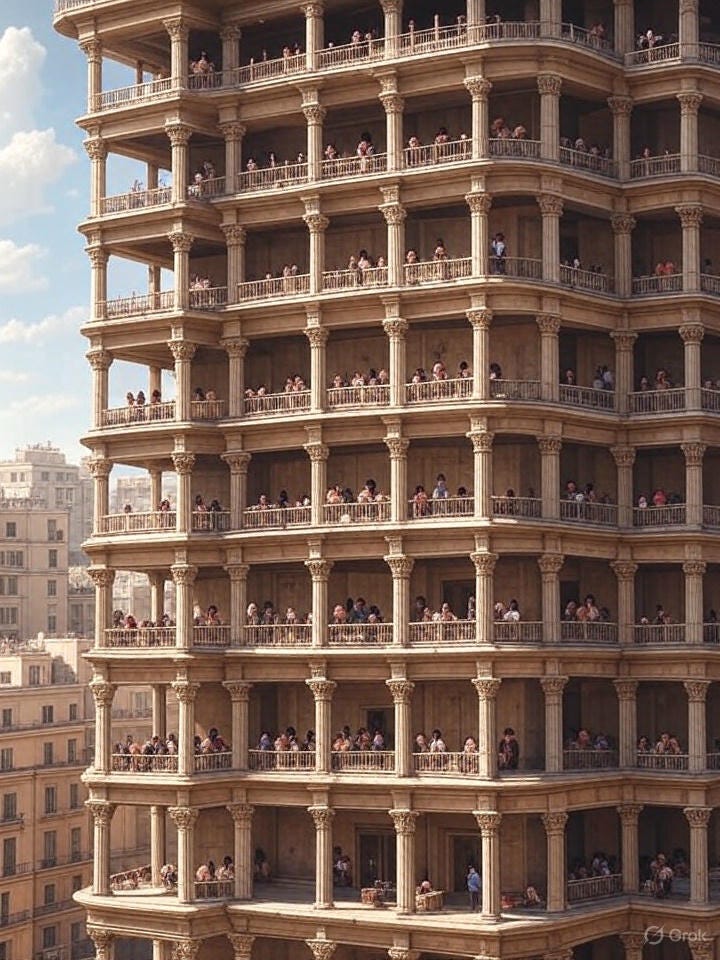TecC 18 - The Square Equation: When Signals Met Systems
How visible handshakes under the invisible hand hastened human progress and prosperity
In our series exploring innovation and progress, in the last couple of episodes we reached a significant milestone. The ability to offload our thoughts and ideas onto devices external to our mind, which then facilitated the creation of entities larger than the individual - institutions, of which we touched upon one of the most important. Let’s now look at another important one instituted in a somewhat different way from that one.
We saw that the institution of State, aided by the administrative (bureaucratic) and legal (regulatory) infrastructure enabled by writing, emerged as this very important institution - after all almost anything you read under the banner of ‘history’ is an account of how the State,1 almost invariably together with one or more prominent individuals who wrested control of it, went about their affairs, and that of others!
Now let’s go back to our alliteratively named Bronze-Age buddies to, as per tradition, fictionalize the development of this other institution.
Gather to Gain and Grow
In the last couple of episodes we saw how Bryan has worked out a nice system of representing quantities and then artefacts on the medium of clay using strokes (writing) and then used that to set up shop helping folk in the community keep account of things they are exchanging with others. We saw how this venture grew and grew as more and more folk saw the value of what he was helping them with, and how he then enlisted Brenda to help out - his trusty dog Bruno as the mascot elevated to the title of ‘Supervisor’.2
Brenda here is the astute one: given the increasing demand for their services, she comes up with an idea. Why not convene a daily 2-hour get-together at the town square - the commons, where Bryan shall administer to the needs of who wants to exchange what with who. This shall be a convenient place for each potential seller and buyer to make known what they have to offer or what they are looking for, with Brenda keeping the records of the proceedings (and Bruno providing supervisory tailwags!)
Ok I think you can see where we are going with this. Yes, this is the institution of the Market!
Over time Brenda comes up with solutions for other issues that become more glaring as the scale of the operation increases. For example, the cow-seller is not satisfied that his counterparty the sheep-offerer only has 2 sheep as he insists his cow is worth three of them. The solution: the sheep-offerer gives out a sackload of barley equivalent to the worth of the third sheep, or equivalent to a third of the cow. Eventually, people start using the notion of quantities of barley to measure the value of anything they wish to trade. And Brenda puts up the detail on a big clay tablet on the premises - with details of how many pounds of barley each good is agreed to be worth.
Again, you are right, this is the birth of money!
Words, Worth and Weight
I’ve previously written about how (spoken) language is an instinct that distinguishes us from other living beings, without which none of the elements of human progress we’ve covered in this series would have been possible or sustainable across generations. Trading or exchange is another such similar instinctual trait we possess. There is indeed some degree of exchange and reciprocity amongst other animals, especially our primate cousins, but it comes nowhere near a sustained practice as we see in human societies.
It’s not hard to see that the aforementioned ability to use language, and its augmentation we’ve just been exploring in the form of writing, have a huge amplifying effect on this capability in humans.3 And trading was carried out long before the technological stage we are in at this point in this series, but in the early Bronze Age these other innovations came together to make possible the emergence of a much more systematized setting where to carry out trading, as we saw in the above imaginary but very likely account of how it might have come about.
The other enabling element here as we also saw is a systematic way of measuring the value of the goods to be traded - money, or currency. I’ve emphasized previously that money in itself has no value, it’s in fact just a measure of value. You can use cash as a store of value too but that is secondary, money emerges as a way of measuring value, and as we have seen, makes for an efficient improvement over any system of barter - direct exchange of goods.
It also allows for the easy expression of that singularly most important signal in the economy - prices (I’ll get to more of this in detail in another article for it’s easy to underestimate the importance of the price mechanism). In our story above we saw barley, as it did happen in Mesopotamia in the early bronze-age period, as that measure of value. But grain is perishable, and there was another important drawback to it. Let’s explore this along with some of the actual historical developments in the Bronze Age going back to the Ancient Near East.
Networks of Need and Nurture
The emergence of a local setup and system of exchanging goods between friends and family and the slightly wider community is all well and good. But what happens when we get further afield? Firstly, a perishable item cannot work effectively as money, for obvious reasons. This necessitated the eventual adoption of some neutral object that had the important property of scarcity, because only with a scarce object can you reliably operate a currency system. This might have been shells, a rare type of stone, a type of leather,4 but eventually most societies ended up with certain metals that were hard to find: yes, silver and gold.5
The other advantage such a system of currency offered, as opposed to something like grain, was it could scale not just time (no perishability issues) but also space.
At the peak of the Bronze Age there existed an extraordinarily mature, sophisticated and globalized system of trade networks. I’ve previously mentioned the growth first of city-states and then larger kingdoms within the Mesopotamian region, what’s called the Cradle of Civilization. But perhaps the most amazing example of what I’m referring to is the interdependent system between the polities of the Mycenaeans (in what later comes to be called Greece), the Hittites (in Anatolia, modern-day Turkey), and the Ancient Egyptians.
Of these we only know about the Ancient Egyptians and their swashbuckling, Pyramid-building, larger-than-life-inscription-carving Pharaohs in popular lore, but these two other civilizations were no less in any way. All three of them had elaborate systems of accounts and inventory management, well developed legal frameworks under which for markets to operate, and over time an extensive set of alliances and treaties to consolidate their sometimes-warring but otherwise largely mutually interdependent and synergistic coexistence.
Perhaps the best indication that they were peers is that the relationships between the rulers of these 3 kingdoms were often forged and sealed in the form of marital alliances, similar to the practice in Julio-Claudian Rome.6
From the Bottom Up, Above and Beyond
At the start of this piece I promised to introduce one institution, but I’ve ended up talking about a few related ones. Very broadly I can say that this was a discussion of the institution of the Market, which it is. But the idea of money, the notion of currency, the broader monetary system, can be defined as an institution itself as well, closely related but somewhat different from the core market. Beyond that we get to the question of jurisdiction.
For the market system to function well - and this is something you will hear mentioned early on if you take an Economics course, there has to be a functional legal system within which for trading to take place. In the Bronze Age, Ur-Nammu and the later and better-known Hammurabi instituted legal codes defining how among others, markets would work within the polity. Within the polity (jurisdiction), there is also the need for a system of courts that adjudicate disputes between parties in a transaction. (And for that to function well, there is the idea of contracts (and covenants) which I’ll come back to in much greater detail later in the series - but just let’s keep in mind this one thing for now: the State is largely a top-down, centralized institution, whereas the Market is bottom-up.)
And then there is the question of across jurisdictions - as we have seen, our tricontinental trendsetters the Hittites, Mycenaeans and Egyptians, had an elaborate set of arrangements that enabled international commerce. Thanks to these and a few other innovations in this period, the Ancient Near East rose to dizzying heights with an extraordinary set of artefactual and institutional innovations and accomplishments. But they weren’t the only ones, we haven’t even looked at one of the most outstanding ones yet: an even more methodical embodiment of such progress and achievement that would astound this trio. Watch this space.
“Study history, study history. In history lies all the secrets of statecraft.” - Winston Churchill
Or was it ‘Salivator’
It’s hard to imagine chimpanzees buying and selling goods solely by grunts and screams, although you might have second thoughts on that when you watch videos of a stock exchange operating in the 1900s!
Such as ‘buckskin’ which is perhaps where the buck starts!
Which persists to this day as traders scramble to buy gold each time there’s a noticeable distress signal in the economy
There have been jokes and snide comments about how daughters, such as Julia the Elder of Augustus, were the currency of the Julio-Claudians and without them these men would have trouble making political alliances





This is an amazing piece, Ash. I think the market is also a mirror of our collective trust. When Brenda posts barley prices on that tablet, she’s not just setting values. She’s codifying a shared belief that makes trade possible. This trust, fragile yet powerful, is what allowed those Bronze Age networks to thrive across continents. We can view markets not just as economic engines but as living agreements to honour each other’s contributions